
Sunk July 7th, 1942

The German Submarine, U-701, is in the Atlantic Ocean off Cape Hatteras, North Carolina, far from her home. She came to the American shore during World War Two on a mission to send American and Allied vessels to the bottom. Due to the skill and luck of the American defenders along with the classic fate of war, she now rests on the bottom of the Western Atlantic sharing the fate of her victims.
The Birth of the Boat
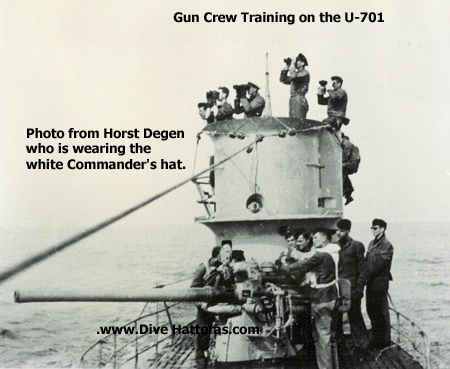 The U-701 had come to life in 1941 at the
Stulkenwerft yard in
Hamburg.
She was the first in the series of 500 ton U-boats (type
VII-C) produced there,
hence the designation 701. Being the first boat out of this yard, she had
some construction problems; the air and oil lines were not properly fitted and
the electrical wiring had been done incorrectly, as well as many other
errors. These problems made for a lengthy build time and the U-701 was
finally commissioned on July 16, 1941. During April of 1941 Horst Degen
(Captain of the U-boat) and many other members of the crew began their association with the boat even
before she was commissioned, when they were called to Hamburg to aide in the
completion of construction. After the launch, 701 went to Kiel for her sea
trials in the Baltic. So many problems were identified the boat was
eventually ordered to return to the Stulkenwerft yard for six weeks of
corrective repairs. After repairs, 701 went back to the Baltic and completed the
trials allowing the crew to train in surface gunnery and torpedo attacks. After
a short time back at the yard, the U-701 departed Kiel for her first war patrol
on December 27, 1941.
The U-701 had come to life in 1941 at the
Stulkenwerft yard in
Hamburg.
She was the first in the series of 500 ton U-boats (type
VII-C) produced there,
hence the designation 701. Being the first boat out of this yard, she had
some construction problems; the air and oil lines were not properly fitted and
the electrical wiring had been done incorrectly, as well as many other
errors. These problems made for a lengthy build time and the U-701 was
finally commissioned on July 16, 1941. During April of 1941 Horst Degen
(Captain of the U-boat) and many other members of the crew began their association with the boat even
before she was commissioned, when they were called to Hamburg to aide in the
completion of construction. After the launch, 701 went to Kiel for her sea
trials in the Baltic. So many problems were identified the boat was
eventually ordered to return to the Stulkenwerft yard for six weeks of
corrective repairs. After repairs, 701 went back to the Baltic and completed the
trials allowing the crew to train in surface gunnery and torpedo attacks. After
a short time back at the yard, the U-701 departed Kiel for her first war patrol
on December 27, 1941.
The War Patrols
Degen and the U-701 spent the first war patrol in an attempt to patrol the waters off Newfoundland, Canada. This first war cruise was very difficult and while enroute to the operational area the First Watch Officer, Lieutenant Weinitschke, was swept overboard and lost on 31 December, after going on deck in heavy weather without a safety belt. The sole success for this five week cruise was the sinking of a 3 to 4000 ton freighter off Rockhall believed to be the Baron Erskine, even though Degen and his crew fired eleven torpedoes at a number of different targets. The Baron Erskine was attacked with two torpedoes during daylight hours in mid January and one of them hit their mark. After the sinking, Degen approached two lifeboats from the sunken ship and attempted to speak with the men in the boats. They refused to answer any of his questions and he left them to search for other ships. A gale came up shortly after the sinking and none of the men in the life boats were heard from again. This terrible weather lasted for almost ten days slowing the U-Boat's advance to just a few miles daily. Degen tried to maintain a topsides bridge watch until a gigantic wave tore loose one of the bridge guns and the gun struck the Second Watch Officer, severely injuring him. Degen dived the boat and stayed submerged for nearly a week to ride out the storm, surfacing only briefly to air the boat and charge batteries. Making things even worse, British antisubmarine warfare units made the rest of the patrol hard going. Kapitanleutant Degen faced some severe criticism from his superior, Admiral Donitz, due to the poor outcome of this patrol and the rash expenditure of the eleven unsuccessful torpedoes.
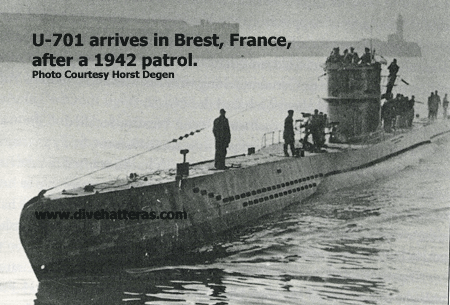 For their second war cruise, the U-701 departed St. Nazerine,
France, to
patrol the area near Iceland and
the Faeroes to work the Northwest approaches to England. During this patrol,
Degen attacked four armed
trawlers, two of which were confirmed sunk by the British, the HMT Notts County
and HMT Stella Capella. The other two vessels did not go down and returned
to port. A single torpedo shot sent the fish carrier Hengist to the
bottom as well. After these attacks, the weather became extremely bad and though
ships were sighted, none could be attacked. At the end of the patrol the
U-701 was ordered to the U-boat base in Brest instead of St. Nazerine as a recent
allied raid had damaged much of the St. Nazerine U-Boat base. On April 15, 1942, the U-701 slid
into a U-boat shelter in Brest where she again underwent an overhaul while most
of the crew enjoyed liberty ashore.
For their second war cruise, the U-701 departed St. Nazerine,
France, to
patrol the area near Iceland and
the Faeroes to work the Northwest approaches to England. During this patrol,
Degen attacked four armed
trawlers, two of which were confirmed sunk by the British, the HMT Notts County
and HMT Stella Capella. The other two vessels did not go down and returned
to port. A single torpedo shot sent the fish carrier Hengist to the
bottom as well. After these attacks, the weather became extremely bad and though
ships were sighted, none could be attacked. At the end of the patrol the
U-701 was ordered to the U-boat base in Brest instead of St. Nazerine as a recent
allied raid had damaged much of the St. Nazerine U-Boat base. On April 15, 1942, the U-701 slid
into a U-boat shelter in Brest where she again underwent an overhaul while most
of the crew enjoyed liberty ashore.
The American Cruise
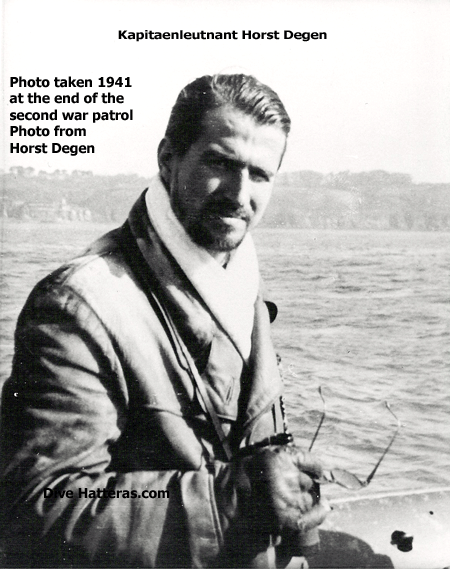 On May 19th, 1942, the U-701 left Brest, France, on her third and what would
turn out to be her final war patrol. She had been in the sub pen for
nearly five weeks and three new men had joined her crew. When she slipped
the lines a band was playing from the quayside and U-701 was escorted to sea by
two patrol vessels and a pair of Messerchmitt fighter planes. Once clear of the
port, the U-701 proceeded to Lorient where she took on a full load of fuel oil
from a tanker. Two days later the
U-701 was fully fueled and armed with 14 torpedoes and Degen took the boat to
sea in the company of another U-boat setting his course for the east coast of
the United States. Most of the crew would never return and for the
survivors it would be many years before they came home to Europe again.
On May 19th, 1942, the U-701 left Brest, France, on her third and what would
turn out to be her final war patrol. She had been in the sub pen for
nearly five weeks and three new men had joined her crew. When she slipped
the lines a band was playing from the quayside and U-701 was escorted to sea by
two patrol vessels and a pair of Messerchmitt fighter planes. Once clear of the
port, the U-701 proceeded to Lorient where she took on a full load of fuel oil
from a tanker. Two days later the
U-701 was fully fueled and armed with 14 torpedoes and Degen took the boat to
sea in the company of another U-boat setting his course for the east coast of
the United States. Most of the crew would never return and for the
survivors it would be many years before they came home to Europe again.
The Atlantic crossing took 22 days for the U-701. This was due to keeping the engines at "langsame fahrt" - the slowest speed setting to conserve the precious fuel supply as well as to some heavy weather that was encountered. There was also the delay caused by two brief pursuits of Eastbound ships that had been sighted mid-ocean. One of the Eastbound vessels Degen stalked for half a day before discovering she was the Swedish liner Drottningholm that was carrying Axis diplomats from New York. This was discovered when Degen had worked into a position very near the liner and saw the Swiss flag and the word "diplomat" painted on the vessel's side. Obliged to allow the ship to pass, he had lost a day and a half of westing to the effort, not to mention the wasted fuel oil. His second sighting proved too fast for the U-701 to maneuver into a firing position and more time and fuel lost to the effort.
Into Action
On June 11, 1942 the U-701 arrived over the continental shelf of the East Coast and Kapitanleutant Degen was reluctant to make landfall as it was a new moon and he considered it "bad for business". The new day of June 12th brought the U-boat it's first aerial attack from an American bomber defending the coast. The U-701 was forced to make a crash dive and when the sub was approximately 40 feet down the aircraft dropped five bombs which straddled the diving sub. The lights went out, glass covers on the control room instruments shattered and the attack left the crew a bit rattled. The damage was slight and quickly repaired, but unknown to the Captain and crew a harbinger of things to come. The Kapitanleutant later told his captors that he decided to lay over the shelf for a few days before making a close approach to the coast. However, this was not true as he proceeded immediately to his first mission.
The U-701 was to patrol the area from the Chesapeake Bay lightship South to Cape Lookout, North Carolina and the sub made landfall in the vicinity of this small lightship. But before stalking ships to sink the U-701 had to get rid of the mines she was carrying in her torpedo tubes. During the night, the U-701 used the Cape Charles and Cape Henry lighthouses as reference points to strategically place 15 magnetic mines in the approaches to the Chesapeake Bay and the safe harbors of Hampton Roads and the Baltimore Harbor further up the bay. Later this day, the boat's first two torpedoes were fired at a small freighter; but both of them missed the target and it escaped. The next night, Degen surfaced the boat to find himself near a small cutter which challenged him with a signal lamp. Fearing that the boat was about to be rammed by the cutter, Degen turned and ran without answering the challenge.
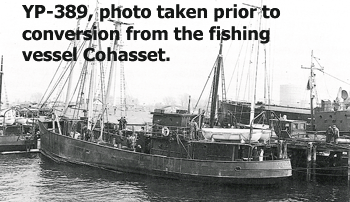 The next day
Degen again encountered what he believed to be this same
cutter. This cutter was now escorting a large tanker and a freighter in
line ahead and the cutter turned back towards the U-701 as soon as the escorted
vessel were out of range. The cutter dropped depth charges near the
U-701's position, but without effect. Degen did not know how the cutter
had detected the submarine as no Asdic "pings" had been heard.
Again the U-701 escaped damage from contact with this enemy. The very next
night Degen ordered the U-701 to the surface, only to again find this pesky
adversary nearby.
Anxious to eliminate this threat to his patrol, Degen ordered the 88mm deck gun
into action. The gun crew began a rapid fire barrage directed at the
cutter, which returned fire from only machine guns. This gun battle lasted
almost an hour and the deck gun crew of
the U-701 used
every type shell in the ready ammo locker, firing an unorthodox mixture of SAP,
HE and incendiary shells at the target. Degen later admitted to his
captures that this was an "untidy" bit of work that he was ashamed of,
as the crew had not performed properly. Untidy it may have been but it was
effective, sinking the cutter that turned out to be the YP-389. The
YP-389 could not return effective fire with her larger 3" deck gun
due to a faulty firing pin, turning the luck of war in the favor of the
U-701.
The next day
Degen again encountered what he believed to be this same
cutter. This cutter was now escorting a large tanker and a freighter in
line ahead and the cutter turned back towards the U-701 as soon as the escorted
vessel were out of range. The cutter dropped depth charges near the
U-701's position, but without effect. Degen did not know how the cutter
had detected the submarine as no Asdic "pings" had been heard.
Again the U-701 escaped damage from contact with this enemy. The very next
night Degen ordered the U-701 to the surface, only to again find this pesky
adversary nearby.
Anxious to eliminate this threat to his patrol, Degen ordered the 88mm deck gun
into action. The gun crew began a rapid fire barrage directed at the
cutter, which returned fire from only machine guns. This gun battle lasted
almost an hour and the deck gun crew of
the U-701 used
every type shell in the ready ammo locker, firing an unorthodox mixture of SAP,
HE and incendiary shells at the target. Degen later admitted to his
captures that this was an "untidy" bit of work that he was ashamed of,
as the crew had not performed properly. Untidy it may have been but it was
effective, sinking the cutter that turned out to be the YP-389. The
YP-389 could not return effective fire with her larger 3" deck gun
due to a faulty firing pin, turning the luck of war in the favor of the
U-701.
While the U-701 was dodging surface vessels and aircraft 100 miles to the south,
her previous efforts began to pay off. The British armed trawler, Kingston
Ceylonite, was sunk after striking one of the mines placed by Degen.
Two other ships, both tankers, were also heavily damaged by the mines at the
same time. Two days later a collier, Santore, also hit the
minefield and was sunk. The U.S. Navy then successfully swept the harbor
approaches of the rest of the sea mines and no further causalities occurred from
Degen's surprise packages. Several days later the U-701 received a coded
message of congratulations for the mining success from Admiral Donitz, chief of
the German U-boat services. 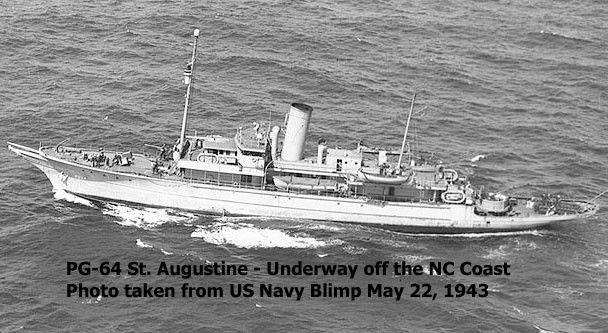
The U-701 went for a few days without further encounters, until Degen sighted a convoy during the daylight. He ordered the boat into firing position on a medium sized tanker and let loose two torpedoes. One hit the mark towards the aft of the vessel and set the tanker afire but Degen did not wait to see the effect of the second as Destroyers were headed his direction. The "ping" of the sonar gear was heard by the crew and depth charges rained down. The depth charge attack from the escort St. Augustine (PG-54) lasted several hours and many "wasserbombs" exploded very close to the U boat. The electric motors were knocked out of commission and the glass in the gauges again shattered, but the boat survived. Unknown to Degen at the time, the tanker he had attacked was the British Freedom of almost 7,000 tons. She did not sink and was able to proceed under her own power to Norfolk where repairs were made.
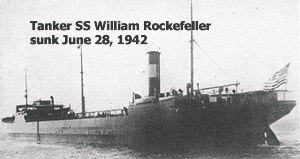 The crew of the U-701 used the darkness of the next night to lick their minor
wounds but they were unable to make full repairs to the air circulating
equipment that had been damaged. However, they were able to transfer two torpedoes stored on deck into the boat's forward
room to be made ready for use. The crew would not have to wait long to
make use of them as the very next day Degen found another tanker to shoot at, this time a
large one, and he trailed it submerged. Though the tanker had an escort of aircraft to
protect it Degen took the chance given him and fired at the big target; a single crippling shot
known to the submariners as a "Fangschuss". He
then crash dived the boat and was immediately attacked by the aircraft.
The bombs and depth charges fell from the plane too far away and the U-701
escaped the second attack from the air and the same for several depth charges
dropped from the U. S. Coast Guard Cutter 470 which the U boat crew heard
explode harmlessly far away. When it grew dark, Degen surfaced
the boat to find the crippled tanker nearby and still burning, it's crew having
been taken off to nearby Ocracoke Island. He fired a
second torpedo to finish off the William Rockefeller and sent a valuable
tanker to the bottom; along with her cargo of 136,000 barrels of Bunker C Oil. The Kapitanleutant had been lucky in his attack as
the William Rockefeller had been escorted by two Coast Guard cutters as
well as three aircraft and one of the cutters had stayed in the area waiting for
a salvage vessel but did not see the submarine when it fired the fatal kill shot
on June 28th.
The crew of the U-701 used the darkness of the next night to lick their minor
wounds but they were unable to make full repairs to the air circulating
equipment that had been damaged. However, they were able to transfer two torpedoes stored on deck into the boat's forward
room to be made ready for use. The crew would not have to wait long to
make use of them as the very next day Degen found another tanker to shoot at, this time a
large one, and he trailed it submerged. Though the tanker had an escort of aircraft to
protect it Degen took the chance given him and fired at the big target; a single crippling shot
known to the submariners as a "Fangschuss". He
then crash dived the boat and was immediately attacked by the aircraft.
The bombs and depth charges fell from the plane too far away and the U-701
escaped the second attack from the air and the same for several depth charges
dropped from the U. S. Coast Guard Cutter 470 which the U boat crew heard
explode harmlessly far away. When it grew dark, Degen surfaced
the boat to find the crippled tanker nearby and still burning, it's crew having
been taken off to nearby Ocracoke Island. He fired a
second torpedo to finish off the William Rockefeller and sent a valuable
tanker to the bottom; along with her cargo of 136,000 barrels of Bunker C Oil. The Kapitanleutant had been lucky in his attack as
the William Rockefeller had been escorted by two Coast Guard cutters as
well as three aircraft and one of the cutters had stayed in the area waiting for
a salvage vessel but did not see the submarine when it fired the fatal kill shot
on June 28th.
After this attack, Degen had to surfaced the U-701 more often than normal because the air scrubbers were out of action and within hours of submerging the interior air became very hot and foul. Upon surfacing, they opened the hatch and ran the diesels with the air intakes closed as this would quickly pull fresh air into the interior through the open hatch. This solved the immediate problem of foul air but exposed them to persistent danger while surfaced as they were attacked by aircraft almost every time they surfaced over the next several days. The Kapitanleutant kept the boat on the bottom during the daylight hours as long as he could since he wanted to avoid this danger as much as possible.
Aerial Attack
In the afternoon of July 7th, 1942, the U-701 surfaced for the last time. Degen had to bring the boat up to air out the stale interior and the usual complement of lookouts, including the Captain, manned the bridge. Each lookout had a specific sector to closely watch guarding against surface and aerial attack. Suddenly one of the men, Lt. Konrad Junker, shouted "Airplane - there!" and the others turned to see a U.S. Army bomber very close and approaching fast. Degen ordered a crash dive and the men raced into the conning tower hatch of the diving U-boat. Once secured in the conning tower Degen turned to Junker and told him "you saw it too late" to which Junker simply replied "yes". This would cost many men their lives - including Lt. Junker.
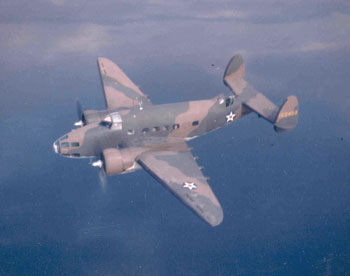 The bomber was an A-29, the same type that had previously attacked them.
This bomber sortie was from the Cherry Point, NC, airfield and conducting
coastal patrol seeking out the German submarines the mission. The aircrew saw the sub
running on the surface and using the cloud cover to their advantage, positioned
the bomber for a perfect run to the target. The pilot, Lt Harry J. Kane, made a his
run at 220mph at an altitude of only 50 feet above the water, quickly closing the
sub from directly astern. They dropped three Mark 17 depth charges, in
rapid succession with only 100 foot spacing, all set to go off at 25 feet
deep. The first bomb fell short of the fleeing U-boat by 25 feet, but the
next two were hits. The bombardier, Cpl. G. E. Bellamy, could see the outline of the U-boat's hull as it dived for cover into the
blue Gulf Stream water
and he clearly saw the 2nd bomb hit about ten feet from the hull and the 3rd bomb
detonate directly on target.
The bomber was an A-29, the same type that had previously attacked them.
This bomber sortie was from the Cherry Point, NC, airfield and conducting
coastal patrol seeking out the German submarines the mission. The aircrew saw the sub
running on the surface and using the cloud cover to their advantage, positioned
the bomber for a perfect run to the target. The pilot, Lt Harry J. Kane, made a his
run at 220mph at an altitude of only 50 feet above the water, quickly closing the
sub from directly astern. They dropped three Mark 17 depth charges, in
rapid succession with only 100 foot spacing, all set to go off at 25 feet
deep. The first bomb fell short of the fleeing U-boat by 25 feet, but the
next two were hits. The bombardier, Cpl. G. E. Bellamy, could see the outline of the U-boat's hull as it dived for cover into the
blue Gulf Stream water
and he clearly saw the 2nd bomb hit about ten feet from the hull and the 3rd bomb
detonate directly on target.
The aerial attack was immediately fatal to the U-701. The pressure hull was torn open in the after compartments and the sea poured in. The instruments in the conning tower were all smashed. Degen ordered the ballast tanks blown, but to no avail, the U-701 would never surface again. They were on the bottom in moments and the boat took a list of 20 degrees to the starboard with the sea flooding in. Within two minutes the control room was almost filled with seawater and the crew was forced to make an escape attempt quickly or they would drown inside the boat.
Degen later recalled that the hatch opened easily and he floated up out of the boat almost effortlessly. As Degen drifted up to the surface he could see his boat on the bottom below him and it seemed to get smaller to him as he was swept up and away in the current. Sixteen other men made their escape through the conning tower hatch to the rough sea surface to join him. Between them they only had one life jacket and three escape lungs for floatation This would cause great suffering and death for many of these unfortunate sailors. The men in the forward torpedo room had been able to dog the hatch to the control room and survive the initial flooding. They had to remove the bracing across the forward torpedo loading hatch opening, then another eighteen men escaped the submarine one after the other through the loading hatch tube which is about twenty inches in diameter and four feet long. These sailors all made the surface about thirty minutes after Degen and the control room men did and they were as poorly equipped as their comrades, since very few had floatation gear for their survival.
Fight for Survival
It would be two days before the survivors were found and taken from the ocean to safety. During this ordeal, they saw their fellow comrades drown one by one. Some of the crewman went mad first, others simply swam for shore and were not seen again. The water was warm preventing death from hypothermia, but the ocean was rough which made the struggle for survival difficult without rafts or floatation gear.
On the next day a ship passed very near the men. Though they shouted and waived they were not seen and this disheartened them greatly. Many planes also passed overhead yet they remained undetected and the Gulf Stream carried them further away from their dead submarine. Later that night the dwindling group came across Apprentice Seaman Laskowski who as wearing two escape lungs. He told them that another group of ten men had also escaped the boat through the conning tower hatch, though he was separated from them now. The struggle went on and during the night the group chanced upon a lemon and a coconut. The coconut was opened after much effort and they all had a sip of the milk and some of the meat, washed down by a bite of lemon. By morning, Laskowski and two others had drowned. According to Degen, one of the men said "I'm taking leave of you, please remember me to my comrades" and then the sailor drowned.
The next morning the group was spotted by the Navy Blimp K-8 from the Naval Air Station at Elizabeth City, NC, and the blimp dropped a life raft and a sack of provisions to the men. Three men were able to climb aboard and they then spotted Degen floating nearby but unconscious. They were able to reach him and pulled him into the raft, saving his life. On July 9th, forty nine hours after the U-701 was sunk, a Coast Guard amphibious plane landed near the raft and took the four survivors from the sea. Three more men were found in the vicinity, separated from each other by a distance of almost five miles. They were all almost ninety sea miles from where their ordeal had begun and thirty six of their comrades had perished, only seven survived.
It did not take long for the survivors to began to be questioned by their saviors. Within three hours Degen and his remaining crew were being interrogated. Even though they were in a weakened state from their ordeal, not too much critical information was reveled. Degen and crew did not admit or mention the mining operation and until after the war it was not known by the U.S. Navy that the U-701 had been responsible for the four casualties in the Chesapeake Bay approaches. Four days after the attack, Degen was introduced to the flight crew of the bomber that had attacked them. Lt. Kane and his flight crew had been ordered up from Cherry Point to meet with the submariners while they were being treated at the military hospital in Norfolk. This event was memorialized in photographs and Lt. Kane received the Distinguished Flying Cross for this action. Kapitanleutant Degen greeted his opponent graciously and congratulated him on his attack with a salute and a simple statement "Good Attack!" The submariners, now POWs, served out the war at POW camps in the US, returning to their homeland in 1946.
Discovery of the U Boat
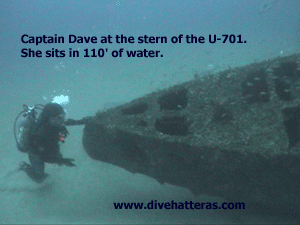 Located ten miles to the East of the Diamond Shoals light tower, the wreck of
the U-701 has attracted the attention of many wreck hunters and divers. Over the
years, many had attempted to locate this German Submarine and dive upon
her. It took the careful research and dogged determination of a very
skilled wreck diver, Uwe Lovas, to locate and document the final resting place
of the U-701. Uwe knew of the existence of this wreck from reading historical
records and became sure of his ability to locate the site after his research led him to another German Submarine wreck, the
U-1105.
Located ten miles to the East of the Diamond Shoals light tower, the wreck of
the U-701 has attracted the attention of many wreck hunters and divers. Over the
years, many had attempted to locate this German Submarine and dive upon
her. It took the careful research and dogged determination of a very
skilled wreck diver, Uwe Lovas, to locate and document the final resting place
of the U-701. Uwe knew of the existence of this wreck from reading historical
records and became sure of his ability to locate the site after his research led him to another German Submarine wreck, the
U-1105.
To locate the U-701, Uwe Lovas spent a great deal of time researching the naval war records and other documents. He then decided that the best chance for success lay in obtaining a Magnetometer, which would allow him to search for the Submarine by locating the influence of it's steel hull on the earth's magnetic field. Not finding a suitable magnetometer available, he made one himself! He also developed a computer program to collect the magnetometer data and collate it with output from a navigation device so he could accurately repeat his search patterns and study the data after a day at sea.
Perseverance paid off and in 1989 Uwe located the U-701 in just over 100' of water about ten miles off the coast of Avon, North Carolina. He was exuberate at the discovery, but realized that when the location became widely know the U-Boat might be heavily dived by artifact hunters. This would go against a promise made to the U-Boat commander, Horst Degen, who had been kind enough to offer important information during Uwe's search process. Uwe allowed only trusted dive partners to assist him while diving the boat and this kept the location a secret for almost 15 years - something almost unheard of in today's wreck diving community.
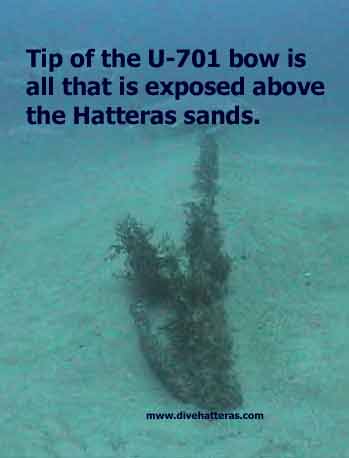 She rests on the sand at 110’ with the highest portion of the wreck, the
conning tower, at around 100’ and the stern slightly deeper when it is
exposed. Wrecks located in this area are subjected to generally high
currents and being periodically covered by the sand. The
sand bottom in this area is constantly moving in large dunes that migrate in the
direction of the current. This causes the U-701 to be periodically covered
or exposed, dependant upon her location in the migrating sand dunes. Her
condition during the Summer season of 2004 was as seen in the accompanying
photos. The stern section is the most exposed it has ever been since
discovery, but the bow was completely covered over. The sand amidships is
at the average height, but has been as high as the top of the conning tower in
the past. The tropical storms that have passed over the wreck since then
have removed much of the sand that once covered over most of the
submarine. In the 2012 season, the U-701 is much more exposed than at
anytime since the late 1980's, the timeframe I have been diving it. There
is now a deep sand scour at both the bow and stern exposing both props and stern
dive planes. The entire bow is now exposed and a diver can swim under the
keel about 35 feet back from the prow. The forward torpedo tube doors and
bow anchor are visible and both bow planes are fully exposed as well. Much
of the under deck machinery and fittings are visible as are the casings for the
spare torpedoes under the forward decking. It is extremely impressive to
see a U-boat in such an intact state underwater.
She rests on the sand at 110’ with the highest portion of the wreck, the
conning tower, at around 100’ and the stern slightly deeper when it is
exposed. Wrecks located in this area are subjected to generally high
currents and being periodically covered by the sand. The
sand bottom in this area is constantly moving in large dunes that migrate in the
direction of the current. This causes the U-701 to be periodically covered
or exposed, dependant upon her location in the migrating sand dunes. Her
condition during the Summer season of 2004 was as seen in the accompanying
photos. The stern section is the most exposed it has ever been since
discovery, but the bow was completely covered over. The sand amidships is
at the average height, but has been as high as the top of the conning tower in
the past. The tropical storms that have passed over the wreck since then
have removed much of the sand that once covered over most of the
submarine. In the 2012 season, the U-701 is much more exposed than at
anytime since the late 1980's, the timeframe I have been diving it. There
is now a deep sand scour at both the bow and stern exposing both props and stern
dive planes. The entire bow is now exposed and a diver can swim under the
keel about 35 feet back from the prow. The forward torpedo tube doors and
bow anchor are visible and both bow planes are fully exposed as well. Much
of the under deck machinery and fittings are visible as are the casings for the
spare torpedoes under the forward decking. It is extremely impressive to
see a U-boat in such an intact state underwater.
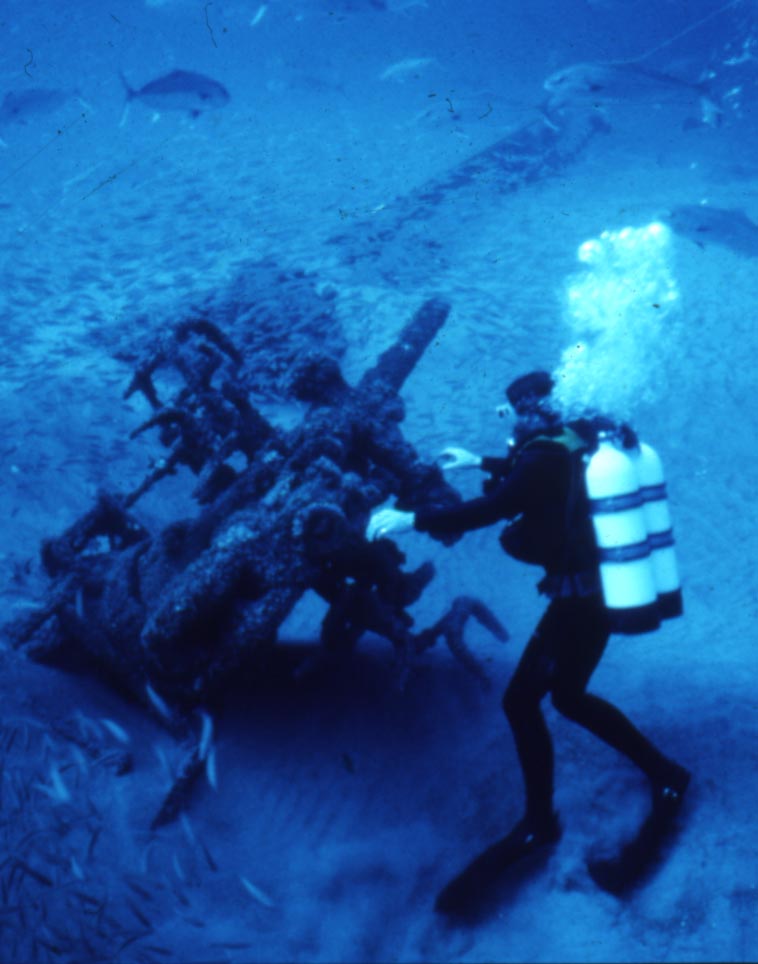 The location of the U-boat was discovered by a local operator in
late 2003 through happenstance and the site became open to all comers.
This has already resulted in the removal of significant artifacts from the boat.
Unknown divers have cut the RDF
The location of the U-boat was discovered by a local operator in
late 2003 through happenstance and the site became open to all comers.
This has already resulted in the removal of significant artifacts from the boat.
Unknown divers have cut the RDF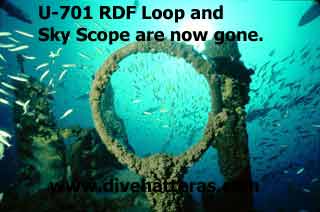 Loop Antenna and the Sky Scope from the conning
tower and removed almost all of the appendages from the deck gun. The accompanying
photo was taken in the 1990s and the gun is now stripped of the safety railings
and handwheels. The conning
tower hatch has also been removed - even though it is just steel that will
simply corrode away once in the air. Many other
loose artifacts have been collected as well. It had been hoped that this
U-boat would have been spared the fate of the others located in
sport diving range off our coasts, but this is apparently not to be. The U-701 may soon
resemble the others when it is stripped of it's periscopes and masts by foolish
divers, a steel
tube laying on the sand. Truly a shame that some divers have a need to cut
apart this rare piece of history...
Loop Antenna and the Sky Scope from the conning
tower and removed almost all of the appendages from the deck gun. The accompanying
photo was taken in the 1990s and the gun is now stripped of the safety railings
and handwheels. The conning
tower hatch has also been removed - even though it is just steel that will
simply corrode away once in the air. Many other
loose artifacts have been collected as well. It had been hoped that this
U-boat would have been spared the fate of the others located in
sport diving range off our coasts, but this is apparently not to be. The U-701 may soon
resemble the others when it is stripped of it's periscopes and masts by foolish
divers, a steel
tube laying on the sand. Truly a shame that some divers have a need to cut
apart this rare piece of history...
Though not particularly deep, the U-701 is an advanced dive. This is due to the normally high current at the site, the long distance and lengthy boat trip to the wreck site. If you make the long trip to this site and find the conditions not dive-able, there are few other options due to the location.
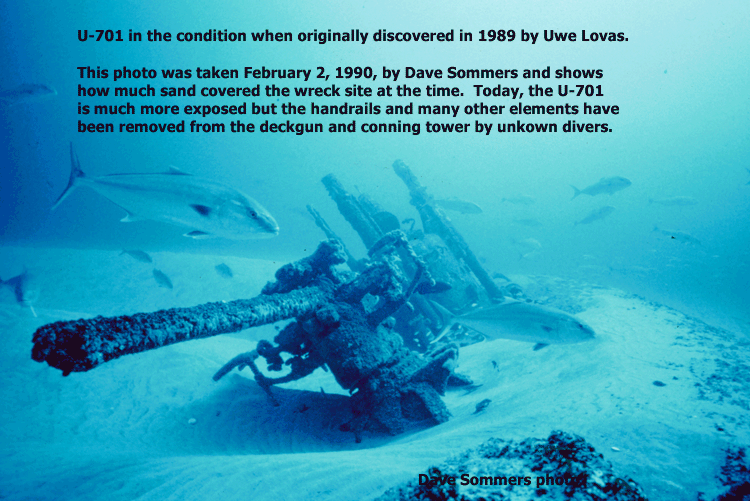
For further photos and information go to the BFDC U-701 page.
Also see the NOAA write up about the U-701.
More information about the U-701 and all other WWII German U-boats can be found at these web sites:
U-Boat.net U-Boat Aces.com U-Boat Archive.net
Sources Used to develop this web page:
1. U.S. Navy Postmortem on Enemy Submarines, #3, ONI 250-G
2. A Careless Word, A Needless Sinking, Captain Arthur R. Moore, 1985 Edition, Lib Con #82-73552
3. Hitler's U-Boat War, The Hunters, 1939-1942, Clay Blair, ISBN #0-394-58839-8
4. Shipwrecks of North Carolina, Hatteras Inlet North, Gary
Gentile, ISBN #0-9621453-7-8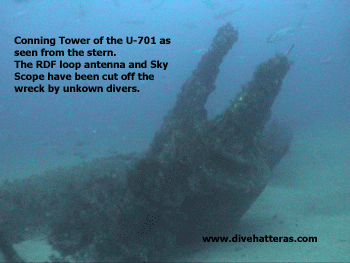
5, Dive into History Volume 3: U-Boats, Henry C. Keatts & George C. Farr, ISBN #1-5592-064-5
6. U-Boats Offshore, Edwin P. Hoyt, ISBN #0-8128-8153-2
Send mail to
webmaster@divehatteras.com with
questions or comments about this web site.
Copyright © 2005
Last modified:
March 17, 2017